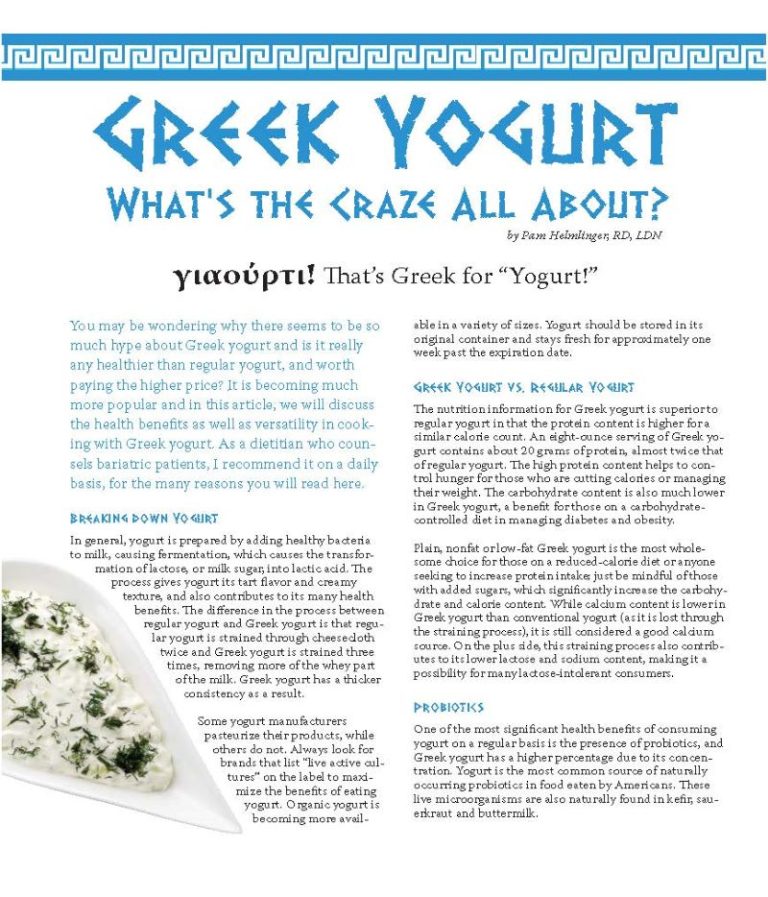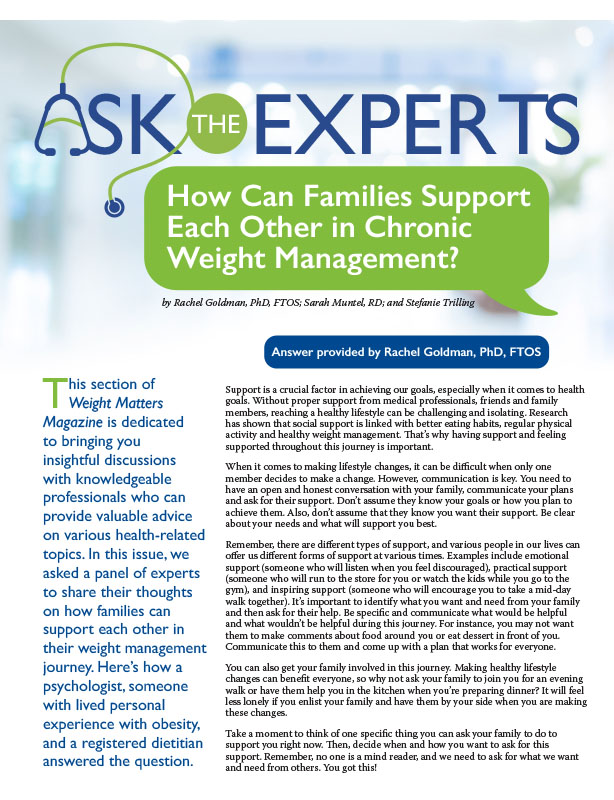Greek Yogurt – What’s the Craze All About?


by Pam Helmlinger, RD, LDN
Winter 2013
γιαούρτι! That’s Greek for “Yogurt!”
You may be wondering why there seems to be so much hype about Greek yogurt and is it really any healthier than regular yogurt, and worth paying the higher price? It is becoming much more popular and in this article, we will discuss the health benefits as well as versatility in cooking with Greek yogurt. As a dietitian who counsels bariatric patients, I recommend it on a daily basis, for the many reasons you will read here.
Breaking down Yogurt
In general, yogurt is prepared by adding healthy bacteria to milk, causing fermentation, which causes the transformation of lactose, or milk sugar, into lactic acid. The process gives yogurt its tart flavor and creamy texture, and also contributes to its many health benefits. The difference in the process between regular yogurt and Greek yogurt is that regular yogurt is strained through cheesecloth twice and Greek yogurt is strained three times, removing more of the whey part of the milk. Greek yogurt has a thicker consistency as a result.
Some yogurt manufacturers pasteurize their products, while others do not. Always look for brands that list “live active cultures” on the label to maximize the benefits of eating yogurt. Organic yogurt is becoming more available in a variety of sizes. Yogurt should be stored in its original container and stays fresh for approximately one week past the expiration date.
Greek Yogurt vs. Regular Yogurt
The nutrition information for Greek yogurt is superior to regular yogurt in that the protein content is higher for a similar calorie count. An eight-ounce serving of Greek yogurt contains about 20 grams of protein, almost twice that of regular yogurt. The high protein content helps to control hunger for those who are cutting calories or managing their weight. The carbohydrate content is also much lower in Greek yogurt, a benefit for those on a carbohydrate-controlled diet in managing diabetes and obesity.
Plain, nonfat or low-fat Greek yogurt is the most wholesome choice for those on a reduced-calorie diet or anyone seeking to increase protein intake; just be mindful of those with added sugars, which significantly increase the carbohydrate and calorie content. While calcium content is lower in Greek yogurt than conventional yogurt (as it is lost through the straining process), it is still considered a good calcium source. On the plus side, this straining process also contributes to its lower lactose and sodium content, making it a possibility for many lactose-intolerant consumers.
Probiotics
One of the most significant health benefits of consuming yogurt on a regular basis is the presence of probiotics, and Greek yogurt has a higher percentage due to its concentration. Yogurt is the most common source of naturally occurring probiotics in food eaten by Americans. These live microorganisms are also naturally found in kefir, sauerkraut and buttermilk.
The main benefits of probiotics are:
- Ensuring proper digestion
- Absorption of nutrients
- Immune health
The potential benefits of probiotics include alleviating diarrhea and constipation, inflammatory bowel disease, ulcers, allergies and lactose intolerance. Probiotics may even protect against colon and bladder cancer. There is limited evidence on the uses and benefits of probiotics and ongoing research is needed to explore them, but eating yogurt is a simple way to include them in your diet. If you have gastrointestinal issues, then it is worth discussing supplementation of a high-potency probiotic with your physician. For patients who have undergone bariatric surgery, such as gastric bypass or duodenal switch, they may also help to treat or prevent some nutritional deficiencies through increased absorption.
Plain Greek yogurt is versatile in that it may be eaten sweet or savory, and can be substituted for many ingredients in cooking, as it does not curdle when heated like regular yogurt. Its thicker consistency also makes it a great addition in place of higher fat ingredients, such as regular sour cream, heavy cream, mayonnaise and cream cheese. Generally, when cooking with Greek yogurt, it is ideal to fold it into other ingredients as stirring will cause it to become thinner.
Cooking Tips and Substitutions
- Replace sour cream in a ranch-style dip with Greek yogurt for a low-fat, high-protein snack to dip cucumber slices, bell pepper strips and carrot sticks.
- Substitute Greek yogurt in place of mayonnaise in chicken/tuna/egg salad recipes.
- Flavor Greek yogurt with your favorite fresh herbs and spices before adding to recipes, or add it to marinades to aid in meat tenderizing.
- Add chopped cucumber and dill weed to plain yogurt and use as a topping for salmon or grilled chicken.
- Top plain Greek yogurt with fresh berries or fruit and a calorie-free sweetener of your choice in place of fruit-flavored yogurt that contains added sugar. Try layering in a wine glass to make a pretty parfait and top with snipped fresh mint as a flavorful garnish!
- Greek yogurt topped with a couple tablespoons of high-fiber cereal or low-fat granola and pumpkin seeds are a perfect way to add a bit of crunch and texture with much fewer calories and carbohydrates versus eating a bowl of cereal.
- Another way to flavor plain yogurt is to add sugar-free preserves or sugar-free gourmet syrups such as those that are added to specialty coffee drinks.
- Mix lime juice (or a crystallized lime packet), a calorie-free sweetener, and a teaspoon of vanilla extract with Greek yogurt for a dessert-like treat in place of key lime pie.
- To increase protein content as a meal replacement and promote fullness, fold in protein powder, or mix in blender with protein powder, water and ice for a creamy shake.
- Try freezing yogurt flavored with sugar-free flavoring or protein powder, such as mint chocolate chip or birthday cake flavored protein powder, for a delicious and healthy frozen treat. Note that freezing yogurt does not harm the friendly bacteria.
- Heating yogurt over 120°F destroys the beneficial bacteria. Instead of mixing directly in a hot liquid, stir a few tablespoons of the hot food into the yogurt, warming it gradually. Next, stir the warmed yogurt into the hot mixture. Add yogurt close to the end of the cooking process in the case of a sauce. Experiment with recipes that call for cream cheese or heavy cream.
- Swap eggs and oil in baked goods for Greek yogurt; while you will not receive the health benefits of the bacteria in this case, it makes for a very moist product.
- If mixture becomes too thin after stirring yogurt in a dip or dressing, thicken it by chilling the mixture for one to two hours.
Conclusion
As you can see, there are a variety of ways that Greek yogurt may be used in cooking and even as a protein-rich meal or snack, depending on your meal plan. In counseling patients on a low-calorie diet, I find they quickly become fatigued with the protein sources they have to choose from and yogurt is a simple meal when one is not up to chewing a three to four ounce portion of meat, fish, poultry or eggs.
If it is prepared as indicated, a six-ounce portion of Greek yogurt contains approximately 100 calories, seven grams of carbohydrate and 18 grams of protein before adding anything to it. Hopefully, if you have never tried Greek yogurt, you now have some incentive to give it a try and some new ideas that maybe you had not thought of in the past. The last tip I would suggest is trying more than one brand of Greek yogurt and tasting it in numerous ways until you acquire a taste for it. Greek yogurt does have a nutritional edge to its counterpart, and I will continue to encourage people to make this simple, healthy swap!
About the Author:
Pam Helmlinger, RD, LDN, has worked with the Center for the Treatment of Obesity at Centennial Medical Center since 2006. She is specialized in bariatric surgery and holds a certificate of training in adult weight management. Currently, she provides pre and post-op nutritional counseling in addition to education for patients in a medical weight-loss program.
by Sarah Muntel, RD Spring 2024 Spring has sprung, bringing sunnier and warmer days! For many, this…
Read Articleby Kendall Griffey, OAC Communications Manager Spring 2024 We have officially kicked off Your Weight Matters Regional…
Read Articleby Rachel Goldman, PhD, FTOS; Sarah Muntel, RD; and Stefanie Trilling Winter 2024 This section of Weight…
Read Article









